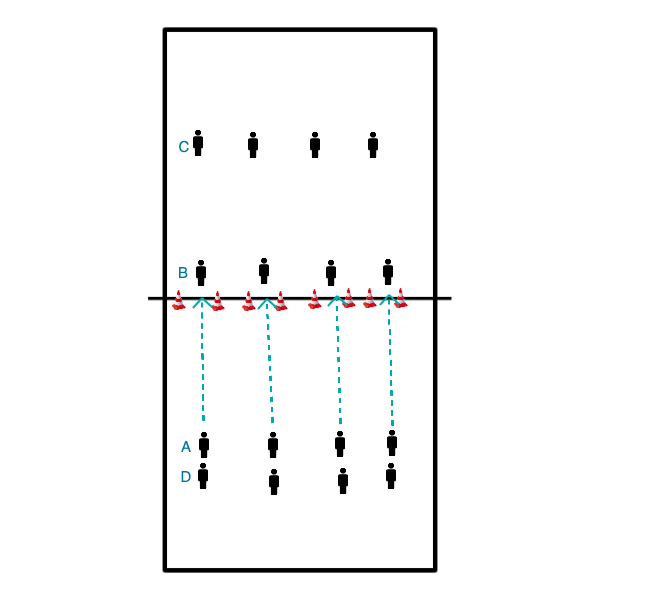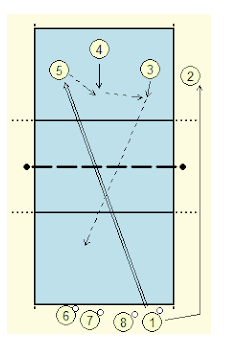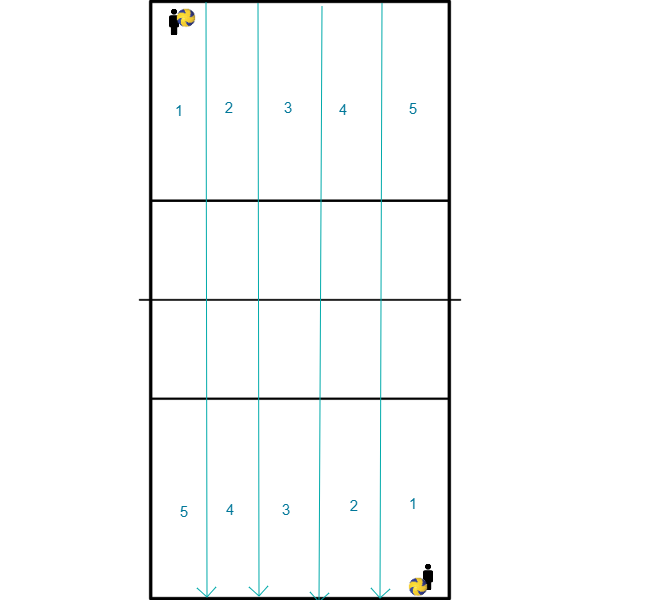Volleyball drills for technique serving
- Put 6 hoops down, on the 6 positions. (P1 t/m 6).
- Make 2 fair teams, easiest is from 4 players per team.
- One person from each team starts in the hoop at position 1.
- The rest of the team stands with a ball on the other side of the hoop, behind the back line and vice versa.
- As soon as the trainer indicates it, both teams start serving on the hoops.
- The person standing in the hoop tries to catch the service without stepping out of the hoop.
- When a service is caught, the person who served the ball moves to position 2, to catch the ball in the hoop.
- The person who was in position 1 goes to his own backline to serve.
- The team that catches the ball first at position 6 is the winner.
- Important is to concentrate on a good service every time.
Practise top hand service.
Build up in steps
- Throwing up ->
- Throw up the ball with 1 or 2 hands.
- Straight up, slightly in front of the body.
- After throwing up, point to the ball with the non-striking arm.
- Drop the ball to the ground, it should land on the service line.
- Catch ->
- The ball is thrown up and caught between the pointing arm and the striking hand.
- Both arms are extended
- Striking ->
- The ball is thrown up and hit.
- Make sure to finish the striking movement (strike through the ball).
Formation: 2 balls per 4 players

1.
- Player A (bowling motion) rolls the ball to player B (the ball must pass between the 2 cones!!).
- Player B picks up the ball, bounces it 2 times and then plays it in a bow to player C.
- Player C holds a hoop and puts the hoop down at the spot where the ball is going to collide. The ball is caught after 1 collision. Player C grabs the ball and joins player D at the back.
- Everyone follows their ball = moves up one place.
2.
- Player A throws the ball under the net to player B.
- Player B catches the ball, bounces once high, does a control key and then bounces to player C.
- Player C catches the ball low to the ground in the correct reception position and runs to D to join the back of the line.
- Everyone follows their ball = moves up one spot.
3.
- Player A throws the ball (bowling motion!) over the net to player B.
- Player B plucks the ball out of the air, bounces 3 times (must turn around during those 3 bounces to face player C) and then tips the ball to player C.
- Player C does reception for himself and joins player D.
- Everyone follows their ball = moves up one spot.
4.
- Player A calmly strikes the ball underhand over the net to player B.
- Player B plucks the ball out of the air, does 1 control bounce, then does control keys until fully turned facing player C and then plays the ball player C.
- Player C does reception for himself, catches the ball and joins player D.
- Everyone follows their ball = moves up one spot.
ON 1 FIELD:
- groups of3/4/5
- 2 groups per field
- 1 group bats, after the serve the person who bats starts to run around the bases around the field (baseball)
- the other group is on the opposite side: 3 persons defend, 1 person catches on position 3
- the defenders have to get the ball to the receiver as soon as possible, when the receiver has the ball in his hands, he will call loudly stop and everybody has to stop walking
- when the server lands in the net or the runners have not reached a base in time, they are out and must wait until the changeover to play again
- when the server hits an ace, this is a homerun: the same goes for when the defenders punt the ball away
- the catcher of the defending team must stand on a mat and may not leave the mat to catch the ball
- when the attacking team has 3 players out, it is a change.
- if you are playing with 3 people, the substitution takes place when 2 people are out, if you are playing with 5 people, the substitution takes place when 3 people are out.
Besides technique, communication is also important in volleyball. And both aspects also apply to this exercise. And reacting adequately to situations which go differently than normal. In such an exercise you can see very well how different players are.

Three players line up to pass (numbers 3, 4 and 5) Player 2 stands ready at the side of the same field of play. The other players stand ready with ball to serve on the other side.
- Player 1 serves the ball (and then immediately walks to where player 2 is already standing).
- A player passes the ball. Another player gives a setup. And the third player plays the ball over the net. All three players must play the ball, either a pass, or a setup, or an attack.
- Once the ball is over the net, the players turn: 2 goes into the court (where 3 was first) 3 goes to mid-back, 4 goes to the spot of 5 and 5 goes the serving spot of the other half.
- Then the next player can serve, on the drawing this is player 8. Etc.
Necessary:
- 4 balls
- 7-8 players
- Someone serves the ball into the court,
- they put a pillon there.
- The other players have to serve as close to that as possible.
- Everyone puts his bottle where he has served,
- Whoever is closest,
- or serves on the pillon,
- can now serve the first ball.
- Ball should not be higher than the antenna
- if necessary string up a rope between the aerials
- Serve on both sides of the net.
Put 2 benches diagonally in field on opposite side of field. Children with ball on back line
- Order: serve behind bench,
- If the ball comes in front of the bench, sit on the bench.
- You can free someone by serving on that person, so they can catch the ball.
Pay attention when getting the ball, walk around the field!
Bounce the ball for yourself and pass to another player
- regular storage
- targeted storage to mats
- jump storage?
- I'm going to divide the court into 1, 2, 3, 4 and 5.
- If I say 2, they must serve in spot 2.
- When I say 4, they must serve in spot 4.
- They take turns serving, so I can see who is successful and who is not.
- 1 is at left back,
- 2 is between left and center,
- 3 is at center back,
- 4 is between centre-back and right-back,
- 5 is right back.
- 2 and 4 are often the positions where there are no players if the pass is made by 3 players.
- If the pass is made by two players, there are no players on positions 1, 3 and 5.
- You can extend this with for example:
- Position 1 short.
- Position 5 sideline. p
- position 4 back line etc.

- Teams of 3 or 4 players.
- One team on each side of the net.
- One court is the winners court (Kings Court).
- From the other court is served.
- The team that wins the point goes to, or stays on, the winners court.
- The losing team leaves the court and is replaced by a new team who will also serve.
- (be ready with a ball !).
- Only self made points from Kings Court count.







